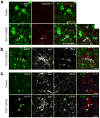Degeneration and impaired regeneration of gray matter oligodendrocytes in amyotrophic lateral sclerosis
- PMID: 23542689
- PMCID: PMC3637847
- DOI: 10.1038/nn.3357
Degeneration and impaired regeneration of gray matter oligodendrocytes in amyotrophic lateral sclerosis
Abstract
Oligodendrocytes associate with axons to establish myelin and provide metabolic support to neurons. In the spinal cord of amyotrophic lateral sclerosis (ALS) mice, oligodendrocytes downregulate transporters that transfer glycolytic substrates to neurons and oligodendrocyte progenitors (NG2(+) cells) exhibit enhanced proliferation and differentiation, although the cause of these changes in oligodendroglia is unknown. We found extensive degeneration of gray matter oligodendrocytes in the spinal cord of SOD1 (G93A) ALS mice prior to disease onset. Although new oligodendrocytes were formed, they failed to mature, resulting in progressive demyelination. Oligodendrocyte dysfunction was also prevalent in human ALS, as gray matter demyelination and reactive changes in NG2(+) cells were observed in motor cortex and spinal cord of ALS patients. Selective removal of mutant SOD1 from oligodendroglia substantially delayed disease onset and prolonged survival in ALS mice, suggesting that ALS-linked genes enhance the vulnerability of motor neurons and accelerate disease by directly impairing the function of oligodendrocytes.
Conflict of interest statement
The authors declare that they have no competing financial interests.
Figures








Comment in
-
Amyotrophic lateral sclerosis: Early involvement of grey matter oligodendrocytes in amyotrophic lateral sclerosis.Nat Rev Neurol. 2013 May;9(5):238. doi: 10.1038/nrneurol.2013.78. Epub 2013 Apr 23. Nat Rev Neurol. 2013. PMID: 23609616 No abstract available.
-
Oligodendrocyte failure in ALS.Nat Neurosci. 2013 May;16(5):525. doi: 10.1038/nn1305-525. Nat Neurosci. 2013. PMID: 23619756 No abstract available.
References
Publication types
MeSH terms
Substances
Grants and funding
LinkOut - more resources
Full Text Sources
Other Literature Sources
Medical
Molecular Biology Databases
Miscellaneous

